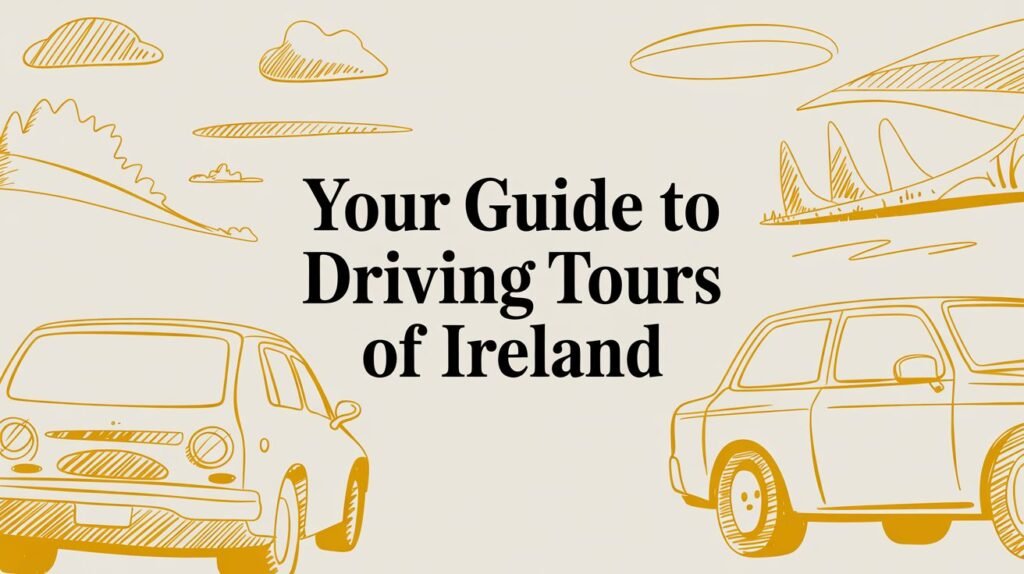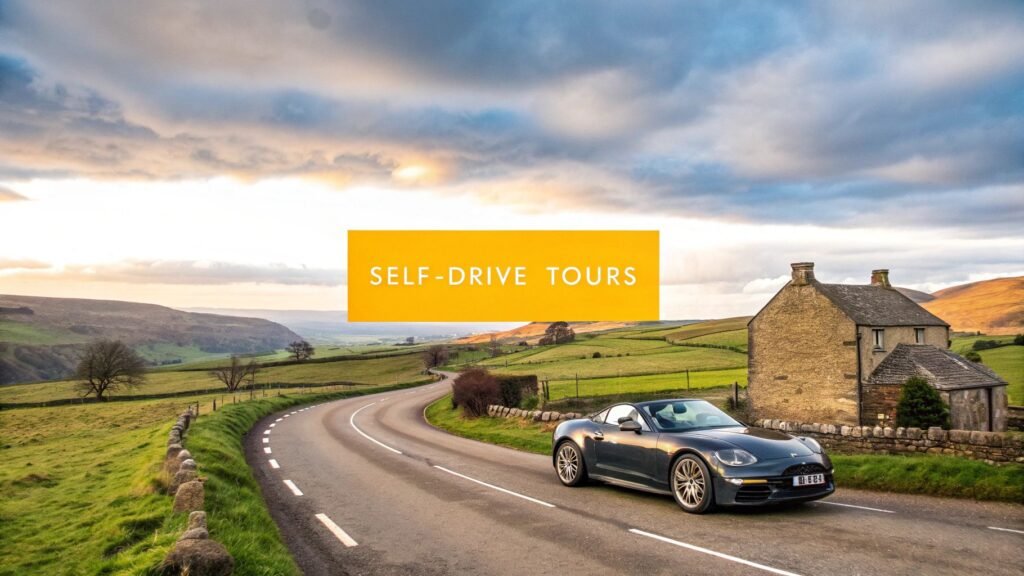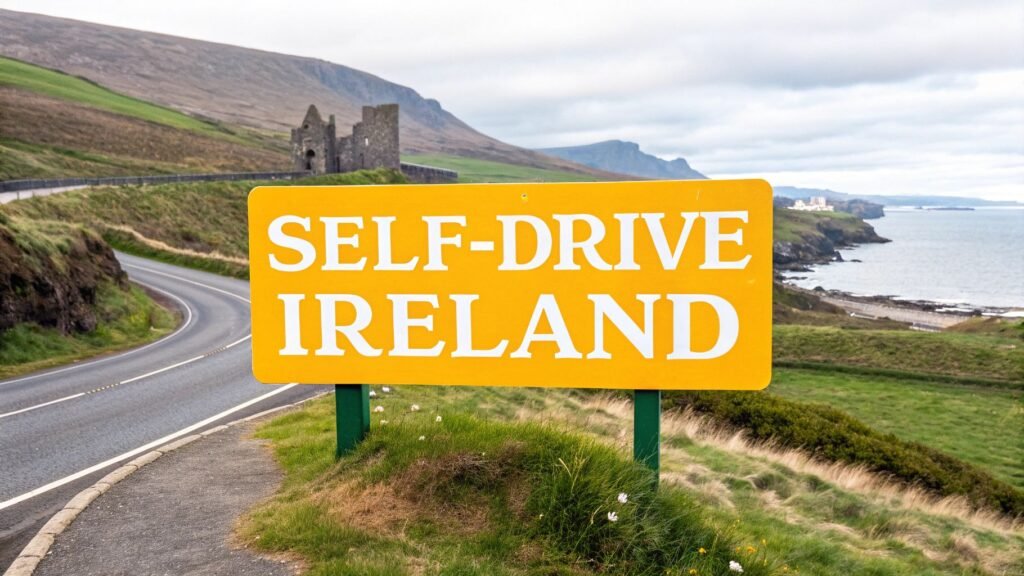Ready to get behind the wheel and truly explore the Emerald Isle? The very best driving tours of Ireland aren’t just about following a map; they’re about combining legendary routes like the Wild Atlantic Way with the sheer joy of discovering hidden gems on your own time. This guide is your co-pilot for planning that perfect adventure, giving you the insider knowledge to create a journey you’ll never forget.
Why Choose a Self-Drive Tour of Ireland
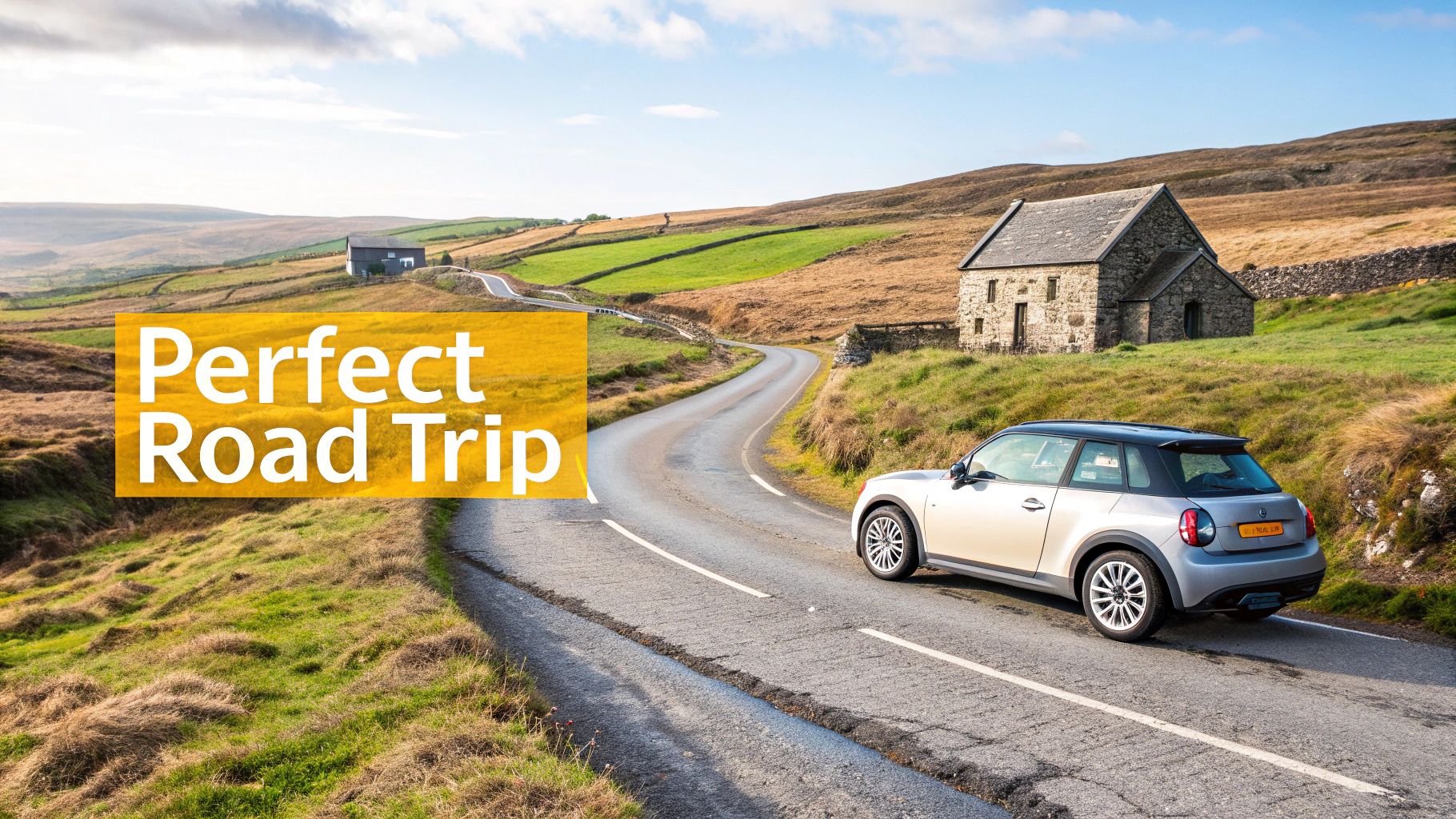
Let's be honest, a road trip is the quintessential way to experience Ireland. It’s not just about getting from one place to the next. It's about the spontaneous detours down a narrow lane, the charming villages you stumble upon by accident, and having the freedom to just stop and soak in a breathtaking view. You are completely in charge.
Picture it: you're cruising along a coastal road, traditional music playing on the radio, when a weathered sign points towards a ruined castle on a clifftop. On a coach tour, you’d sail right past. With your own car, you can follow that sign, wander among ancient stones, and forge a memory that belongs only to you. That’s the real magic of exploring Ireland on your own terms.
The Benefits of a Road Trip Adventure
The powerful appeal of an Irish road trip is the flexibility it gives you and the intimate connection you build with the landscape. It’s your ticket to fully immersing yourself in the experience.
Here’s what makes it so special:
- Ultimate Freedom: You set the schedule. Stop wherever you fancy, for as long as you like. That photo opportunity isn't going anywhere.
- Authentic Discoveries: Veer off the well-trodden tourist trail to find those secluded beaches, welcoming local pubs, and scenic spots that most guidebooks miss.
- A Personalised Pace: Are you an early bird chasing the sunrise or someone who prefers a lazy start? The day is entirely yours to shape.
- Deeper Immersion: Travelling by car lets you see the subtle, beautiful shifts in scenery and culture as you move from one county to the next.
A self-drive tour transforms you from a spectator into an explorer. You're not just looking at Ireland; you're taking part in its story, one winding road at a time.
This independent style is a huge draw for visitors, especially those from the UK. In fact, Great Britain is Ireland's largest tourism market, and British travellers are known for their exploratory spirit. They visit an average of 2.5 regions per trip, compared to 1.9 for other overseas visitors, making a car an absolute must-have for their adventures.
With our comprehensive guide on driving tours of Ireland, we’ll help you map out every detail for a seamless and unforgettable road trip.
Planning Your Itinerary and Budget
A brilliant Irish road trip doesn’t just happen—it’s built on a bit of smart planning. Getting the essentials sorted, from the car you'll drive to where you'll lay your head each night, means you can soak up the adventure without any last-minute stress. Think of it as laying the groundwork for a truly unforgettable journey.
First things first: your wheels. When you go to hire a car in Ireland, you'll quickly discover that manual transmission is the standard. If you're not used to driving a stick shift, you’ll definitely want to book an automatic. Be sure to do this well in advance, as they're not as common and get snapped up quickly, especially during peak season.
Getting this right is a simple step that makes all the difference for any of the great driving tours of Ireland.
Navigating Car Hire and Insurance
Beyond just picking a car, you've got to get your head around the insurance. Every rental includes basic coverage, but you'll almost certainly need to add a Collision Damage Waiver (CDW). This isn't some sneaky upsell; it's what covers damage to the hire car itself. Without it, you could be on the hook for the entire value of the car if you have a prang.
A lot of credit cards offer rental insurance, but here's a crucial tip: double-check if it’s valid in the Republic of Ireland. It's often an excluded country. You need to read the fine print to avoid paying for cover you don't need or, even worse, finding out you're not covered when you need it most. For the best prices, book your car a few months before you travel.
Mastering Ireland’s Roads and Navigation
Once you're behind the wheel, you'll see that Irish roads have a character all their own. You’ve got modern 'M' roads (motorways) that zip you between the big cities, and then you have the 'boreens'—tiny, single-lane country roads that are part of the real Irish experience. Driving the boreens is all about taking it slow and being ready for a friendly wave as you pull in to let someone pass.
For finding your way, a mix of old and new school is the way to go. A GPS or an app like Google Maps on your phone is a lifesaver for navigating towns and cities. But don't write off a good old-fashioned physical road map. It gives you a much better feel for the landscape, helps you spot spontaneous detours, and, most importantly, it never loses signal when you're deep in a remote glen.
Choosing Your Accommodation
Where you stay at night is a huge part of the adventure in Ireland. The country offers a fantastic range of options, each with its own flavour.
- Bed & Breakfasts (B&Bs): For a truly local experience, you can't beat a B&B. You get a warm welcome into a family home, a cosy room, and a massive "Full Irish" breakfast to set you up for the day.
- Hotels: These are perfect if you're after more amenities like an in-house restaurant or bar. You'll find them mostly in larger towns and cities, offering convenience and a bit more polish.
- Self-Catering Cottages: If you plan on staying put for a few days, renting a cottage is a brilliant option. It gives you a real home-away-from-home feel and the freedom to cook for yourself.
A word of advice: book your accommodation well ahead if you're travelling in July or August. During the shoulder seasons of spring and autumn, you can be a bit more spontaneous, often booking just a day or two in advance as you go. For pre-planned trips with all your stays arranged, check out some of the excellent, stress-free https://btours.com/self-drive-tours/ available.
Creating a Realistic Daily Budget
Thinking about a budget isn't about pinching pennies; it’s about knowing what you can comfortably spend so you can relax and have fun. To get a broader perspective on stretching your funds, it's always worth looking into general budget travel tips.
A smart budget is your roadmap to a worry-free adventure. By estimating your daily expenses, you can allocate your funds to what matters most to you, whether that's a gourmet meal or a boat trip to a remote island.
To give you a starting point, here is a sample breakdown of daily costs. This doesn't include your car hire or fuel, but it’s a handy guide for everything else.
Irish Road Trip Budget Estimator Per Person Per Day
Use this sample breakdown of daily costs, excluding car hire, to budget for your driving tour across Ireland.
| Expense Category | Low Budget (€) | Mid-Range Budget (€) | High Budget (€) |
|---|---|---|---|
| Accommodation | €40 – €70 | €70 – €150 | €150+ |
| Food & Drink | €35 – €50 | €50 – €90 | €90+ |
| Attractions & Activities | €15 – €30 | €30 – €60 | €60+ |
| Total Per Person/Day | €90 – €150 | €150 – €300 | €300+ |
Remember, these are just estimates. Your own spending will depend entirely on your travel style, but this table should give you a solid idea of what to expect as you plan your trip.
Discovering Ireland's Most Iconic Driving Routes
Now that you've got the basics sorted, it's time for the best part: choosing your adventure. Ireland's driving routes are legendary, and for good reason. Each one tells a different story, unfolding across unique landscapes and at its own distinct pace. These aren't just A-to-B roads; they are journeys into the heart and soul of the country.
We'll start with the big ones, the titans of Irish road trips, before exploring some lesser-known drives that are just as magical. Whether you're chasing the wild, untamed coastline or the quiet whispers of ancient history, there's a route here with your name on it.
This infographic gives a quick visual guide to the core things you'll be juggling as you get your trip organised.
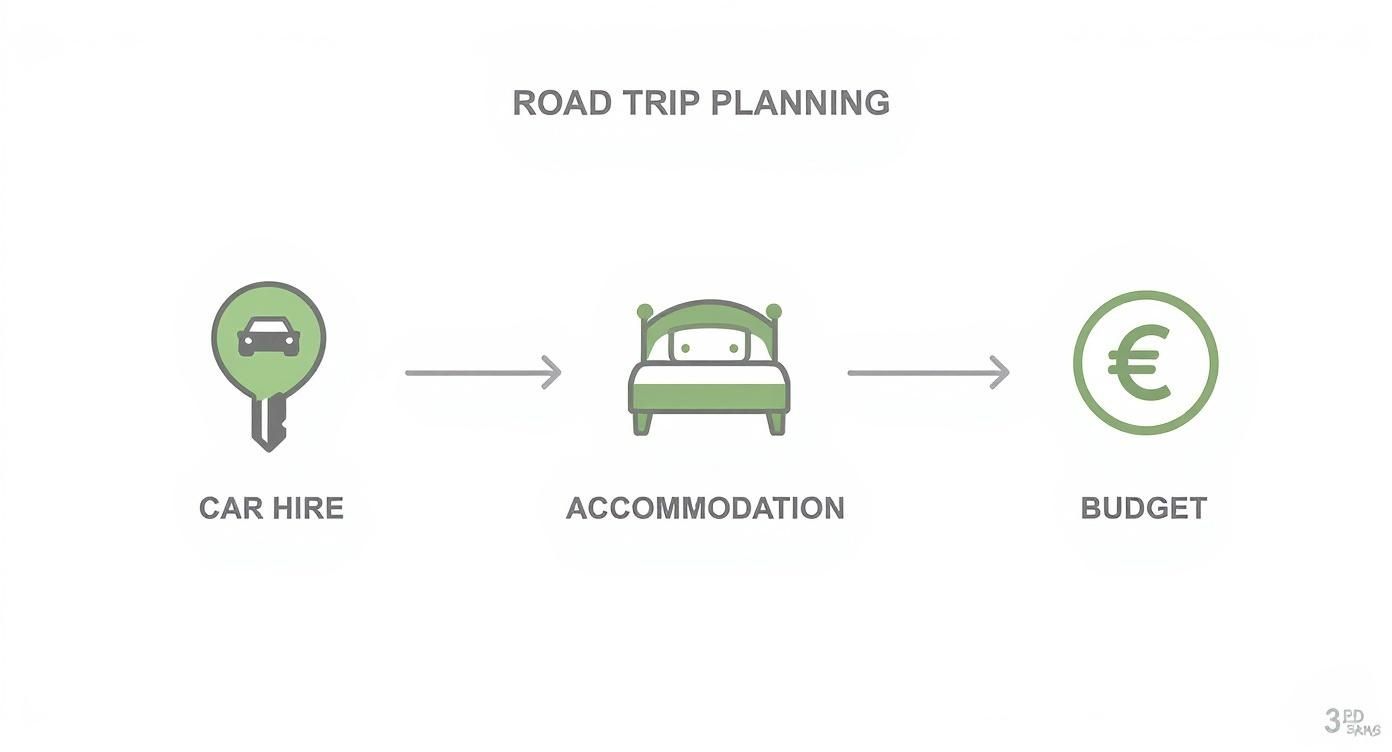
Getting the balance right between your car hire, accommodation, and budget is the foundation of any truly great Irish road trip.
The Wild Atlantic Way: A Coastal Epic
Stretching for a colossal 2,600 kilometres along Ireland's western seaboard, the Wild Atlantic Way isn't just a driving route—it’s an epic. This is Ireland at its most raw and dramatic, a continuous ribbon of road that hugs the tempestuous Atlantic coast all the way from Donegal down to Cork.
Let's be realistic: trying to drive the whole thing in one go is a monumental task. A much better way to think of it is as a collection of regional chapters, each with its own personality.
- The Northern Headlands (Donegal): This is where you'll find the wild, remote, and breathtakingly beautiful Ireland of your imagination, featuring the immense Slieve League cliffs and the pristine beaches of the Fanad Peninsula.
- The Surf Coast (Sligo & Mayo): Famous for its world-class waves, this stretch is also home to the striking silhouette of Benbulben mountain and the serene beauty of Clew Bay.
- The Bay Coast (Galway & Clare): Here lies the bohemian buzz of Galway city, the otherworldly limestone landscape of the Burren, and the absolutely unmissable Cliffs of Moher.
- The Southern Peninsulas (Kerry & Cork): A stunning finale that includes the famous Dingle Peninsula, the Ring of Kerry, and the ruggedly charming Beara Peninsula.
The sheer scale of the Wild Atlantic Way means that even a focused week-long trip will only scratch the surface of one or two regions. The best approach is to slow down, embrace the pace of the coast, and leave room for those spontaneous stops and deep explorations.
For a focused trip, many people find that 10 to 14 days is a good amount of time to explore the highlights of a chosen section. Driving tours are an incredibly popular way to see the island, with many UK visitors mapping out routes that cover over 1,300 kilometres across both Britain and Ireland. To truly savour the experience, a good rule of thumb is to limit your driving to around 100 miles per day. This gives you plenty of time for cultural stops and scenic detours without feeling like you're constantly behind the wheel.
If you want to dive deeper, we have a complete guide to the Wild Atlantic Way in Ireland.
The Causeway Coastal Route: A Journey Through Myth
Over in Northern Ireland, the Causeway Coastal Route packs an incredible amount of drama into just 193 kilometres (120 miles). This drive, which winds its way from Belfast to Derry-Londonderry, is a journey through landscapes steeped in both myth and mind-boggling geology. You could drive it in a day, but it really deserves at least two or three to be properly appreciated.
The undisputed star of the show is the Giant's Causeway, a UNESCO World Heritage site where around 40,000 interlocking basalt columns seem to tumble into the sea. According to legend, the giant Finn MacCool built it as a causeway to Scotland.
Other essential stops along the way include:
- Carrick-a-Rede Rope Bridge: Test your nerve on this swaying bridge, first strung up by salmon fishermen, which connects the mainland to a tiny, rugged island.
- The Dark Hedges: Made famous by Game of Thrones, this enchanting avenue of ancient beech trees forms a magical, almost spooky tunnel over the road.
- Dunluce Castle: The romantic, crumbling ruins of this medieval castle cling dramatically to a clifftop, making for some truly spectacular photos.
Ireland's Ancient East: Uncovering 5,000 Years of History
If the Wild Atlantic Way is all about the power of nature, Ireland's Ancient East is about the power of stories. This region covers the lush green landscapes southeast of the River Shannon, an area that has been at the very centre of Irish history for millennia. It's less of a single, defined road and more a treasure-filled region waiting to be explored.
Here, you can literally travel through time, discovering everything from prehistoric wonders to grand medieval estates.
- Brú na Bóinne: Older than the pyramids, this UNESCO site includes the passage tombs of Newgrange and Knowth, famously aligned with the winter solstice sun.
- The Rock of Cashel: An incredible cluster of medieval buildings perched on a limestone outcrop in Tipperary, this was once the seat of the High Kings of Munster.
- Kilkenny's Medieval Mile: Lose yourself in the cobbled streets of this beautifully preserved medieval city as you wander between its magnificent castle, cathedral, and ancient alleyways.
This is the perfect route for history buffs or anyone who wants to connect with the deep, ancient roots of Irish culture.
Hidden Gems: The Ring of Kerry and Wicklow Mountains
Beyond the major signposted routes, you'll find countless other drives that offer their own brand of magic. Two of the most celebrated are the Ring of Kerry and the scenic drives through the Wicklow Mountains.
The Ring of Kerry is a 179-kilometre circular route in County Kerry, and it's one of Ireland's most famous drives for a reason. It loops around the Iveragh Peninsula, serving up a stunning mix of coastal views, impossibly green hills, and charming villages like Sneem and Waterville. Don't miss the panoramic views from Ladies View or the beautiful Torc Waterfall in Killarney National Park.
Just a short drive south of Dublin, the Wicklow Mountains National Park feels like a different world entirely. Known as the "Garden of Ireland," its driving routes wind through heather-covered hills and past serene lakes. The highlight for many is the ancient monastic settlement of Glendalough, nestled peacefully in a glacial valley. It’s the perfect choice for a day trip from the capital or a quick two-day escape into nature.
Must-Have Experiences Beyond the Road
The best driving tours of Ireland aren’t really about the driving. They’re about what happens when you turn the engine off, step out of the car, and let the real Ireland find you. The scenic routes are just the threads connecting the truly memorable moments—the vibrant culture, the deep history, and the jaw-dropping landscapes you’ll discover along the way.
Think of your car as your personal key to unlocking authentic Ireland. It’s what gets you to that tiny, hidden pub where traditional music spills out onto the cobbled street, or down a narrow lane to a secluded trail leading to a waterfall you’d never find on a tour bus. These are the experiences that stick with you long after you’ve come home.
Immerse Yourself in Culture and History
Ireland’s long and often turbulent story is written right into the land, from its buzzing city streets to its ancient, moss-covered monuments. To really get a feel for the place, you have to dive in.
One of the most essential Irish experiences is stumbling into a live “trad” session in a local pub. Head to a town like Doolin in County Clare, known as a hub for traditional music, find a cosy corner with a pint, and just listen as the fiddles, tin whistles, and bodhráns kick up. It’s pure magic.
For the history buffs, Dublin is an absolute goldmine. A trip to Trinity College to see the Book of Kells is a must-do for a reason. This 9th-century manuscript is a breathtaking masterpiece of medieval art, and seeing its intricate detail up close is a powerful connection to Ireland’s monastic past. For a different vibe, take a day to simply wander the remarkably preserved medieval streets of Kilkenny, where you can almost feel the history in the air.
The real beauty of a driving tour is the freedom it gives you. You can mix the big-ticket historical sites with those spontaneous discoveries. One day you’re gazing at a world-famous manuscript, and the next, you’re the only person at a forgotten stone circle you just happened to spot from the road.
Explore Ireland's Wild Landscapes
While the coastal drives get all the glory, Ireland’s inland beauty is every bit as captivating. To truly appreciate the Emerald Isle, you need to get out on your own two feet and embrace the elements.
Killarney National Park is a walker’s paradise. You’ll find everything here, from gentle, looping strolls around Muckross Lake to more challenging hikes up Torc Mountain that reward you with stunning panoramic views. With its ancient woodlands, glassy lakes, and herds of native red deer, the whole place feels like it's been lifted straight from a fairytale.
If you’re after something a bit more adrenaline-fueled, Ireland’s coast offers more than just pretty views. The beaches of County Sligo and County Donegal are legendary surfing hotspots, where powerful Atlantic swells draw in wave riders from all over the world. Whether you're an old hand or a complete novice taking a lesson, it's an exhilarating way to meet the Wild Atlantic head-on.
Savour the Flavours of the Island
Forget any old stereotypes you’ve heard—Irish food has had a revolution. The focus now is all about celebrating incredible local ingredients from both the land and the sea. Your road trip is the perfect excuse to taste the very best of it.
You can't leave without trying the classics. Find a pub in a coastal village like Kinsale and order a bowl of creamy seafood chowder, which should be packed with fresh fish and served with a slab of hearty brown bread. On a damp, chilly day, nothing beats a rich, warming bowl of Irish stew, traditionally made with tender lamb.
But don’t just stick to the pubs. Make time to explore the local food markets. The English Market in Cork, for example, is a historic covered hall absolutely buzzing with vendors selling artisanal cheeses, locally smoked fish, and all sorts of fresh produce. If you’re a real foodie, you could even build your trip around it with a dedicated itinerary like an 8-day culinary self-drive tour of Ireland that puts fantastic food at the centre of your adventure.
And of course, there are the drinks. A tour of the Guinness Storehouse in Dublin is an iconic experience, and it’s worth it for the finale alone: a perfectly poured pint in the Gravity Bar, which offers amazing 360-degree views over the city. If whiskey is more your style, a visit to a classic distillery like Bushmills or Jameson gives you a fascinating look into the craft of making "uisce beatha"—the water of life.
Essential Tips for Driving in Ireland
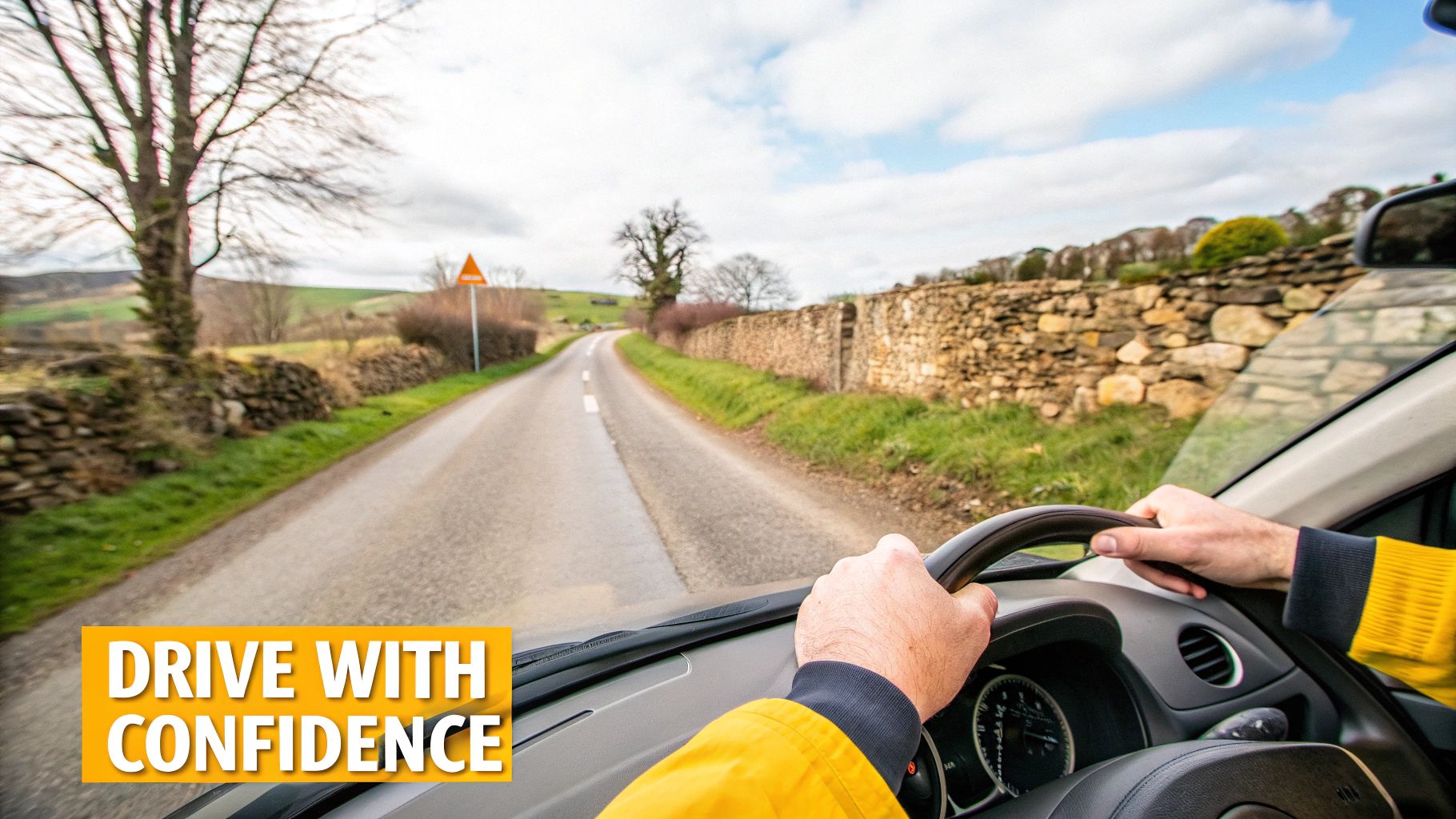
The secret to a fantastic Irish road trip is feeling confident behind the wheel. While the thought of navigating unfamiliar roads might seem a bit intimidating, a little bit of prep work will have you driving like a local before you know it. These tips cover the essential rules and unique quirks you’ll find on Irish roads, helping you stay safe, relaxed, and focused on the stunning scenery.
First things first, and it's the big one for many visitors: in Ireland, we drive on the left-hand side of the road. If you're coming from the UK, you'll be right at home. For everyone else, it’s the main thing to get used to. My go-to tip? Always keep your body, as the driver, towards the centre line of the road. It's a simple mental trick that works wonders.
This is especially critical when you get to junctions and roundabouts. When you approach a roundabout, you have to give way to any traffic already on it (which will be coming from your right), and don't forget to signal when you're exiting.
Understanding the Roads and Signs
Once you get off the main motorways (marked with an 'M'), you'll find yourself on a whole network of other routes. National roads ('N' roads) are the main arteries connecting towns, while Regional roads ('R' roads) are a step down. Then you have the Local roads ('L' roads), which we often call 'boreens'. These can be incredibly narrow, twisty, and sometimes have no centre line at all.
On these smaller roads, it’s all about taking your time. You’ll often need to pull into a gateway or a designated passing spot to let an oncoming car squeeze by. And don't be shocked if you have to stop for a flock of sheep or a herd of cows crossing the road—they always have the right of way!
Road signs in Ireland are bilingual, with place names shown in both Irish Gaelic (Gaeilge) and English. But be aware, in certain Gaeltacht (Irish-speaking) areas, some signs might only be in Gaelic. Having a good map or a reliable GPS is a great backup.
Another crucial point is to watch your speed. The limits are posted in kilometres per hour (km/h), not miles per hour (mph). This is a big difference from the UK, so keep a close eye on your speedometer to avoid getting a ticket.
Navigating Towns and Parking
Driving through Ireland's lively towns and historic cities comes with its own challenge: parking. Finding a spot can be tough, especially in popular tourist hubs. Most towns operate on a "pay-and-display" system, where you buy a ticket from a nearby machine and pop it on your dashboard.
It's a smart move to plan for city parking ahead of time. Looking up parking options near major attractions like Trinity College Dublin can save you a world of frustration and let you get straight to the good stuff.
This preparation is key, as you'll be joining a lot of other explorers. In 2023, Ireland welcomed around 6.3 million tourists, and about 50% of them were here for a holiday, many on a driving tour just like you.
Fuel, Tolls, and Emergencies
Finally, let's talk about the practical bits that keep your journey moving. Keep an eye on your fuel tank, particularly when you’re driving through remote areas like Connemara or parts of Donegal, where petrol stations can be few and far between.
- Fuel Types: At the pump, green handles mean unleaded petrol, and black handles are for diesel. Putting the wrong one in a hire car is a very expensive mistake, so always double-check before you fill up.
- Toll Roads: You'll hit tolls on the main motorways, mostly around the big cities. Most have a barrier where you can pay with cash or a card. The big exception is the M50 ring road around Dublin, which has a barrier-free system. For that one, you need to pay online or at a Payzone shop by 8 p.m. the next day to avoid a fine.
- In an Emergency: The number for police, fire, or ambulance services anywhere in Ireland is 112 or 999. It’s always a good idea to have this saved in your phone before you set off.
Keep these pointers in mind, and you'll be all set for a safe, brilliant, and truly unforgettable driving adventure across the Emerald Isle.
Your Ireland Driving Questions, Answered
As your Ireland road trip gets closer, you're bound to have a few last-minute questions bubbling up. It's completely normal. We've been there, and we've heard them all.
To put your mind at ease, we’ve pulled together the most common queries we get from fellow travellers. Think of this as a final chat with a friend who’s done the trip a dozen times, making sure you’re ready to hit the road with confidence.
How Many Days Do I Really Need for a Road Trip?
This is the million-dollar question, and the honest answer is: it depends entirely on the kind of trip you’re after. It’s tempting to try and see everything, but Ireland is a place that reveals its best self when you slow down. Rushing is the quickest way to miss the magic.
If you’re dreaming of tackling a major route like the full Wild Atlantic Way, you’ll want to give yourself a minimum of 10 to 14 days. That’s the sweet spot for really sinking into a few key regions without feeling like you’re just ticking boxes. It gives you breathing room for that spontaneous detour to a hidden beach or a lazy pint in a village pub.
Got less time? A 7-day trip is still fantastic for a more focused adventure. You could easily spend a brilliant week just in the southwest, for example, properly exploring the Ring of Kerry, the Dingle Peninsula, and the incredible Killarney National Park.
When Is the Best Time of Year to Go?
Let’s be honest, Irish weather is a character in its own right—it does what it wants! But when you choose to visit can definitely shape your experience.
- Spring (April-May): This is my personal favourite. You get those lovely long evenings, the whole country is exploding in colour, and you’ll find fewer people at the popular spots.
- Summer (June-August): Peak season for a reason. You’ll have the longest days and the highest chance of sunshine. Just know that it’s also the busiest and priciest time, so booking your car and places to stay well in advance is essential.
- Autumn (September-October): A fantastic alternative to spring. The summer crowds have gone home, prices often dip, and the landscape is awash with gorgeous autumnal colours.
Do I Need a Special Permit to Drive?
This is a big worry for many, but the good news is it’s usually straightforward. If you’re visiting from the UK, EU, USA, Canada, or Australia, your standard, valid driver's licence is all you’ll need to drive in Ireland for up to 12 months.
That said, it never hurts to be absolutely sure.
Before you fly, just give your chosen car hire company a quick call or email to confirm their specific requirements. A two-minute check can save you any hassle at the pickup desk and get your trip started smoothly.
How Hard Is It to Drive on the Left?
Okay, this is often the biggest mental hurdle, but I promise you, most people get the hang of it faster than they expect. The secret is to just take it easy for the first few hours. Be extra cautious at roundabouts and junctions.
Here’s a tip that makes a huge difference: rent an automatic car. Not having to worry about shifting gears with your left hand frees up so much brainpower to focus on your road position.
And remember this little mantra: "Driver to the middle." As the driver, your shoulder should always be toward the centre line of the road. It’s a simple mental trick that keeps you locked in the correct lane, especially when you’re turning. Before you know it, it’ll feel second nature.
At BTOURS, we specialise in crafting unforgettable self-drive journeys that let you discover the real Ireland at your own pace. Explore our curated itineraries and start planning your perfect road trip adventure today at https://www.btours.com.

